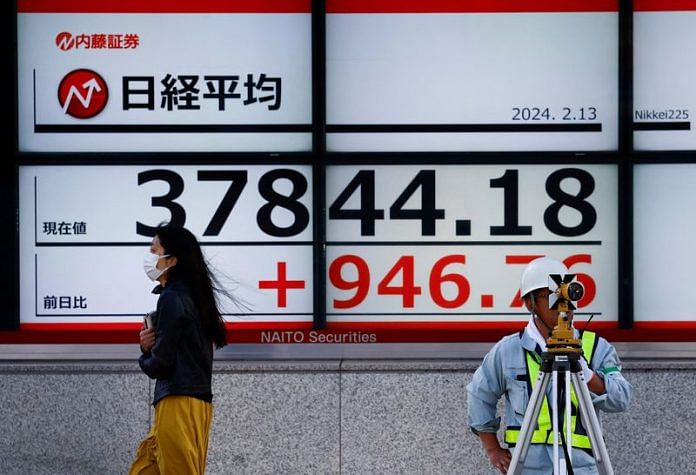By Alun John and Wayne Cole
LONDON/SYDNEY (Reuters) -French bonds fell sharply for a second day on Tuesday as did European stocks and the euro after the announcement of a snap election in France, while investor attention began to turn to Wednesday’s U.S. inflation data and Federal Reserve meeting.
President Emmanuel Macron on Monday called the parliamentary election for June 30 and July 7 following a massive loss for his camp in a European Parliament vote on Sunday.
Opinion polls show Marine Le Pen’s far-right party is likely to win, though fall short of an absolute majority, spooking investors.
Europe’s STOXX 600 index dropped 0.8% with France’s CAC40 down 1.26% after a 1.35% loss on Monday. Banking stocks, such as Credit Agricole, Societe Generale, and BNP Paribas, were down between 3% and 4%.
S&P 500 futures and Nasdaq futures both eased 0.3%.
French bonds also sold off with France’s 10-year yield up 7 basis points at 3.31% having jumped 8 bps on Monday.
With Germany’s 10-year yield a fraction lower at 2.66%, the spread between the two, a gauge of the premium investors require to hold French debt rather than the euro zone benchmark, widened to 64 basis points – its most since October 2023.
“The market reaction is really one of uncertainty, and that was enough to widen spreads,” said Michiel Tukker , senior European rates strategist at ING.
“We’ll see that higher uncertainty until the French elections, and so it’s quite warranted to see higher spreads in the near term.”
Tukker said the lack of strong demand for German bunds suggested uncertainty was driving markets, not a “risk off” flight to safety.
The ructions spread to currency markets where the euro dropped 0.3% on the dollar to $1.0731, a one month low, 0.4% against the pound to 84.24 pence, a 21 month low, and also shed 0.3% against the Swiss franc.
Meanwhile, across the channel, investors were digesting data showing Britain’s labour market showed more signs of cooling in April as the unemployment rate rose.
While this is unwelcome news for Prime Minister Rishi Sunak ahead of a July 4 election, it could enable the Bank of England to cut interest rates in August. Next week’s inflation data will offer a better guide, however.
The 10-year gilt yield dipped around 2 basis points to 4.31%, and the pound held steady against the dollar at $1.2739.
ONE CUT, OR TWO?
On Wall Street, markets showed a muted reaction to Apple’s long-awaited AI strategy, which integrates “Apple Intelligence” technology across a suite of apps. The iPhone maker’s shares shed 0.4% in premarket trading having slipped 1.9% in normal hours on Monday.
The biggest scheduled economic events of the week are due on Wednesday, with U.S. consumer price inflation and the Federal Reserve policy decision.
The Fed is considered certain to hold steady at the conclusion of its two-day meeting on Wednesday, with the focus on whether it keeps three rate cuts in its “dot plot” projections for this year.
“We expect the dots to show two cuts in 2024, four cuts in 2025, three cuts in 2026 and a slight tick up in the longer-run or neutral rate,” said analysts at Goldman Sachs in a note.
“We think the leadership would prefer a two-cut baseline to retain flexibility, but a one-cut baseline is a possible risk, especially if core CPI surprises to the upside on Wednesday.”
The consumer price index (CPI) is forecast to rise a slim 0.1% in May, but with its core measure up 0.3%.
Rate futures imply 38 basis points of Fed easing for this year, compared to 50 bps before the jobs report.
The other central bank meeting this week is the Bank of Japan, which might decide to taper its bond buying at a policy meeting ending on Friday, as a step toward another rate hike.
Assuming markets aren’t disappointed by the size of the change, this could support the embattled yen. The dollar was up 0.2% at 157.38 yen, its highest in a week
Gold was just above one-month lows at $2,306 an ounce, after getting whiplashed by the pullback in market pricing for U.S. rate cuts. [GOL/]
Oil prices consolidated Monday’s 3% rally, as investors awaited monthly oil supply and demand data from the U.S. Energy Information Administration and OPEC on Tuesday, and the International Energy Agency on Wednesday. [O/R]
Brent futures were steady at $81.48 a barrel.
(Reporting by Wayne Cole in Sydney and Alun John in London; Editing by Rashmi Aich, Emelia Sithole-Matarise and Tomasz Janowski)
Disclaimer: This report is auto generated from the Reuters news service. ThePrint holds no responsibilty for its content.



